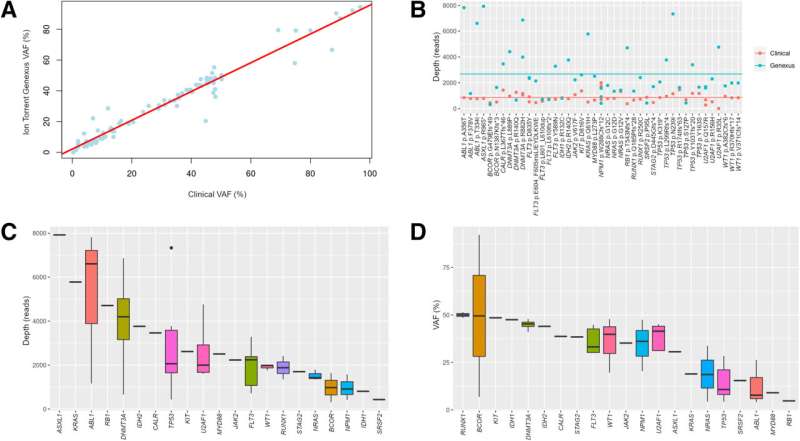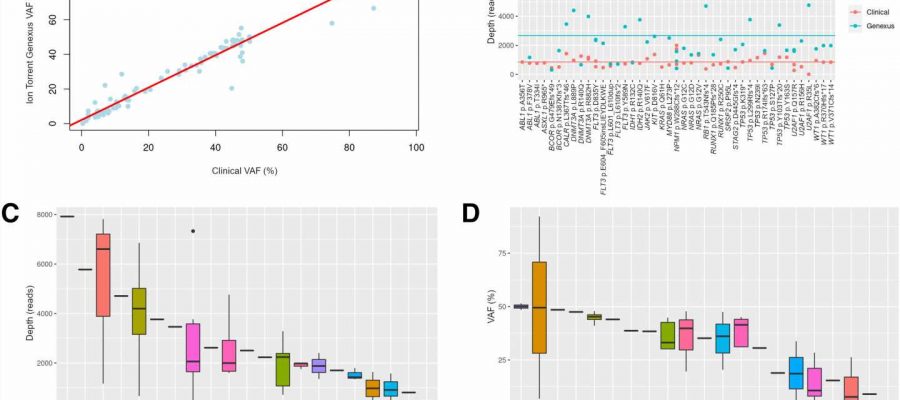
Identifying recurrent genetic alterations in myeloid neoplasms has improved diagnosis and expanded targeted treatments available to patients. However, treatment initiation can be delayed by the variable and lengthy turnaround times involved in testing for these alterations.
In a novel study, researchers evaluated an integrated next-generation sequencing (NGS) system and found that it can deliver accurate, genomics-based diagnoses to accelerate time to precision therapies, thus benefiting patient outcomes. Their results appear in The Journal of Molecular Diagnostics.
In myeloid neoplasms, the bone marrow produces too many or too few red blood cells, platelets, or certain white blood cells. The discovery of recurrent genetic alterations in myeloid neoplasms has improved diagnostic accuracy and expanded the targeted treatment options available to patients. This progress is especially relevant in improving treatment of acute myeloid leukemia (AML), for which there is currently a dismal 30.5% relative five-year survival rate.
Current National Comprehensive Cancer Network (NCCN) guidelines now endorse genetic testing for AML. Recently, a number of drug-targeted therapies relying on the presence or absence of specific gene alterations have emerged. These drugs are used not only for relapsed or refractory disease, but also as a component of induction chemotherapy for certain patients.
“The successful implementation of these therapies relies on immediate knowledge of the leukemia’s genetic features,” explained lead investigator Kojo S.J. Elenitoba-Johnson, MD, Department of Pathology and Laboratory Medicine, Memorial Sloan Kettering Cancer Center, New York, NY, U.S., who was at the Department of Pathology and Laboratory Medicine, Perelman School of Medicine at the University of Pennsylvania, Philadelphia, PA, U.S., at the time the study was conducted.
Determining leukemia’s genetic features involves testing for recurrent, diagnostically, and therapeutically relevant genetic alterations. Unfortunately, current diagnostic tools use multiple technologies, different domains of expertise, and unconnected workflows, resulting in markedly variable and lengthy turnaround times that can delay treatment.
“NGS is a powerful tool capable of identifying most of these alterations; however, current NGS platforms and bioinformatics bottlenecks represent significant barriers to an optimal and timely diagnosis, with turnaround times often exceeding 10 to 14 days, thereby delaying treatment decisions,” Dr. Elenitoba-Johnson noted. “As a result, laboratories typically perform redundant testing to support a more rapid turnaround time for key variants.”
To address the need for identifying these alterations more efficiently, investigators evaluated the Oncomine Myeloid Assay GX panel on the Ion Torrent Genexus platform, a rapid (less than 24-hour nucleic acid to result turnaround time) integrated nucleic acid NGS platform for detecting clinically relevant genetic aberrations in myeloid disorders.
Specimens included synthetic DNA (101 targets) and RNA (9 targets) controls and real-world nucleic acid material derived from bone marrow or peripheral blood samples (40 patients). Clinical DNA and RNA samples were retrospectively identified from blood or bone marrow specimens that had already undergone nucleic acid extraction and genetic testing in a Clinical Laboratory Improvement Amendments (CLIA) certified clinical laboratory following previously validated protocols.
Results and performance indices were compared with those obtained from clinically validated genomic testing workflows in two separate clinical laboratories. The assay identified 100% of DNA and RNA control variants. For specimens derived from patients, it reported 82 of 107 DNA variants and all of the 19 RNA gene fusions identified on clinically validated assays, yielding an overall 80% detection rate. Reanalysis of exported, unfiltered data revealed 15 DNA variants that were not initially identified, yielding an overall 92% potential detection rate.
These results are promising for implementing an integrated NGS system to rapidly detect genetic aberrations, facilitating accurate, genomics-based diagnoses and accelerate time to precision therapies in myeloid neoplasms.
“There are significant laboratory workflow benefits using this platform compared with the current testing methods,” commented Dr. Elenitoba-Johnson.
“Automated and integrated workflow-based platforms that deliver clinically relevant results in less than 24 hours could revolutionize the diagnostic workup of neoplastic conditions, potentially improving patient outcomes. The availability of accurate results in clinically relevant timescales will enable deployment of genomic studies in the frontline for diagnostic evaluation of patients. Automated workflows such as these will improve operational efficiency and have significant economic impact on laboratory expenses given the reduced requirement for human involvement in carrying out the laboratory tests.”
More information:
Christopher M. Sande et al, Rapid and Automated Semiconductor-Based Next-Generation Sequencing for Simultaneous Detection of Somatic DNA and RNA Aberrations in Myeloid Neoplasms, The Journal of Molecular Diagnostics (2022). DOI: 10.1016/j.jmoldx.2022.11.005
Journal information:
Journal of Molecular Diagnostics
Source: Read Full Article
